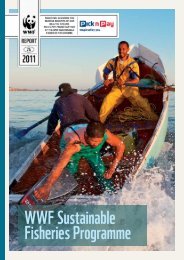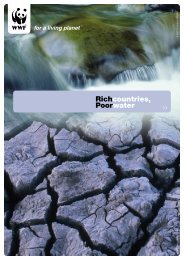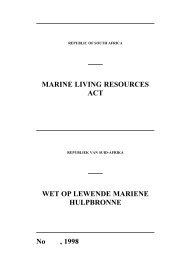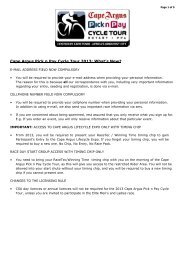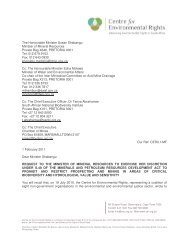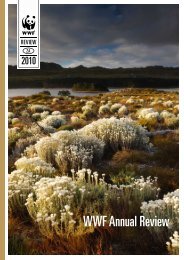State of Management of South Africaââ¬â¢s ... - WWF South Africa
State of Management of South Africaââ¬â¢s ... - WWF South Africa
State of Management of South Africaââ¬â¢s ... - WWF South Africa
- No tags were found...
You also want an ePaper? Increase the reach of your titles
YUMPU automatically turns print PDFs into web optimized ePapers that Google loves.
STATE OF MANAGEMENT OF SOUTH AFRICA’S MARINE PROTECTED AREASThe Skulpiesbaai restricted zone at Noordkapperspunt, incorporating the vywersThe estuary <strong>of</strong> the Goukou River from approximately 4km upstream <strong>of</strong> the mouth to apoint 15km from the mouth.The remainder <strong>of</strong> the MPA is a controlled zone.Areas critical for the maintenance <strong>of</strong> the ecological integrity <strong>of</strong> the MPA and the culturalheritage have been included within its boundaries and afforded extra protection(approximately 75% <strong>of</strong> the estuary and 20km 2 <strong>of</strong> reef systems are restricted). Zones wereadequate for all the activities in the MPA.6.4.4 MPA <strong>Management</strong> PlanEXISTENCE OF PLAN, OBJECTIVES AND REGULATIONS (83%)A comprehensive management plan for the MPA had recently been drafted. At the time <strong>of</strong>the assessment it was not yet approved but was being used to guide management. The planlisted the broad objectives for MPAs under the MLRA, the generic biophysical, social andgovernance objectives provided by CapeNature that are applicable to the MPA, as well asthe specific objectives for Stilbaai MPA as provided in the regulations. The management planis designed so to aid in the achievement <strong>of</strong> these objectives. Allowable and restrictedactivities are dealt with clearly in the plan. The plan required that a supplementarymanagement plan be developed for the estuary.PLAN IMPLEMENTATION AND ADEQUACY (92%)The management plan set out priorities and facilitated resource allocation. The plan did notindicate specific management actions to be taken but work plans and operational plans couldbe easily formulated by using the management plan as a reference. The manager indicatedthat the desired future state was clearly articulated and could be used as a decision makingreference point and that the plan was useful in its current form. The adequacy <strong>of</strong> the plancould be attributed to the manager’s direct involvement in the planning process.SOCIO-ECONOMIC CONSIDERATIONS (75%)Notices <strong>of</strong> the planning procedures were made available in newspapers, on the radio and inpamphlets that were made available to the public. All interested parties were invited toparticipate and comment in the planning process and a meeting was held with the localliaison committee. However no active efforts were made to engage meaningfully with thethree local communities. Details <strong>of</strong> the historical sites associated with the MPA and culturalpractises were provided and the different local communities were described and consideredin the sections for compliance and awareness. The requirements for managing the vywerswere still to be investigated through a workshop at the time <strong>of</strong> the assessment.Pg 87






